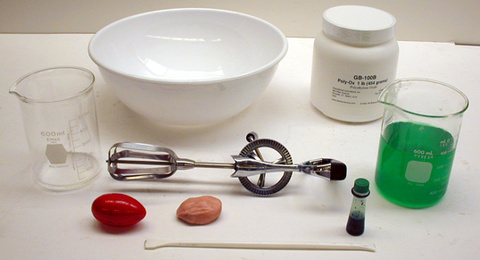Breadcrumb
2C60.00 - Non-Newtonian Fluids

Code Number: 2C60.00
Demo Title: Non-Newtonian Fluids
Condition: Excellent
Principle: High Viscosity Fluids
Area of Study: Fluids
Equipment:
Egg Beater or Mixer, Food Coloring, Two 600 ml Beakers, Large Mixing Bowl, Silly Putty, Polyethylene Oxide, Corn Syrup.
Procedure:
Mix the polyethylene oxide according to directions. Add some food coloring to make it easily visible. The directions for mixing this are: mix 20-25 ml of a dry alcohol such as anhydrous methanol or ethanol with 3-4 grams of polyethylene oxide in a clean, dry 600 ml beaker. Swirl the mixture to completely wet the resin with alcohol. Add 350-400 ml of tap water in the mixture "in one pour" and stir until the resin has gelled completely.
The unusual properties of the gel can be seen in two ways. One is to start pouring the gel from one beaker to the other. Once the pour has been started the gel will continue to siphon even if the pouring beaker is turned upright. If you look closely you will see that the gel moves up the side of the beaker in a thin film which thickens to a strand as it falls to the other beaker.
The second way to demonstrate this is with an egg beater or mixer. First use corn syrup and the mixer. Turn the mixer up to the first speed and show that the corn syrup is thrown away from the beaters. Then do the same thing with the polyethylene gel. This time notice that the liquid not only climbs the beaters but that eventually the whole gel mass is on the beaters.
A mixture of 2 parts corn starch to 1 part water will make a very fun and interesting non-Newtonian fluid. If you take some into the palm of your hand, the fluid will run through your fingers very easily, However, if you strike the mixture or try to make it move very quickly, it will set up like a solid and you will leave no dents in the surface. One of the names given to this mixture is "MUNG".
Set the silly putty on a very solid surface. HIT THE PUTTY VIOLENTLY WITH THE HAMMER!!! Due to the fact that silly putty has a lower viscosity for slow shear rates and a high viscosity for fast shear rates the putty will shatter like a large crystal.
References:
- "Front Cover", TPT, Vol. 55, #9, Dec. 2017.
- Piotr Habdas, Eric R. Weeks, and David G. Lynn, "Squishy Materials", TPT, Vol. 44, # 5, May 2006, p. 276.
- Jearl Walker, "Serious Fun with Polyox, Silly Putty, Slime and Other Non-Newtonian Fluids", The Amateur Scientist, November, 1978.
- Jearl Walker, "Easy Ways to Make Holograms and View Fluid Flow, and More Funny Fluids", The Amateur Scientist, February, 1980.
- Norman J. Wagner, John F. Brady, "Shear Thickening in Colloidal Dispersions", Physics Today, October 2009, p. 27.
- "Persistent Holes", Physics Today, July 2004, p. 11.
- 50 Fun Experiments for the Mad Scientist in You, "Dancing Oobleck", National Geographic Kids, p. 90.
- Martin C. Sagendorf, "That 'Non-Newtonian' Fluid", Physics Demonstration Apparatus, 2009. p. 144.
- Matthew Francis, "A Striking Experiment Shows How You Can Run on Quicksand", Nature, July 11, 2012
- Jearl Walker, "2.58, Strange Viscous Fluids", The Flying Circus of Physics Ed. 2, p. 105.
- Jearl Walker, "2.61, Rod-Climbing Fluids", The Flying Circus of Physics Ed. 2, p. 107.
- "Oobleck", Countertop Chemistry, The Science House, North Carolina State University.
- "Gluep", Countertop Chemistry, The Science House, North Carolina State University.
- "Clear Slime Polymer", Countertop Chemistry, The Science House, North Carolina State University.
- Christopher P. Jargodski and Franklin Potter, "131, Flow from a Tube", Mad About Physics, p. 49, 191.
- Christopher P. Jargodski and Franklin Potter, "132, Spheres in a Viscous Newtonian Liquid", Mad About Physics, p. 49, 191.
- Christopher P. Jargodski and Franklin Potter, "133, Spheres in a Viscous Non-Newtonian Liquid", Mad About Physics, p. 49, 191.
- #94, "Slime", Janice VanCleave's 203 Icy, Freezing, Frosty, Cool, and Wild Experiments.
- #97, "Cold Stuff", Janice VanCleave's 203 Icy, Freezing, Frosty, Cool, and Wild Experiments.
- #96, "Hot Stuff", Janice VanCleave's 203 Icy, Freezing, Frosty, Cool, and Wild Experiments.
- "Mung", - Directions For The Making Of A Non-Newtonian Fluid Based On Corn Starch.
- Joey Green, "Green Slime", The Mad Scientist Handbook, Vol. 1, p. 37.
- Joey Green, "Quicksand", The Mad Scientist Handbook, Vol. 1, p. 77.
- Bobby Mercer, "Non-Newtonian Goo", Junk Drawer Chemistry, 2016, p. 16.
- Borislaw Bilash II, “If Only Newton Knew“, A Demo A Day – A Year of Physical Science Demonstrations, p. 104.
- Borislaw Bilash II, “A Slimy Polymer“, A Demo A Day – A Year of Physical Science Demonstrations, p. 199.
- Borislaw Bilash II, "Yuk - Its Gak“, A Demo A Day – A Year of Physical Science Demonstrations, p. 200.
An excellent website for this type of action